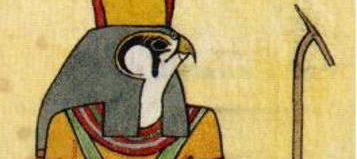Neopythagorean numerology – specifically, speculation regarding the nature of the first ten numbers – was a prevalent feature of Gnostic, Hermetic, and “magical” texts of the first few centuries CE. The ancient writers themselves called this speculation “arithmetic” (ἡ ἀριθμητική), but in the nineteenth century scholars began to call it “arithmology” to distinguish it from simple arithmetic in the modern sense.
An example of arithmology occurs in the early third-century Refutation of All Heresies 4.43.4 ff., possibly written by Hippolytus of Rome.
The Egyptians suppose themselves to be more ancient than everybody else. By reckoning up the power of God and the degree intervals [of the Zodiac or decans], they declared by most divine inspiration that God is an indivisible, self-generating Monad, and that out of the Monad the universe is constructed. Being unborn, they say, the Monad gives birth to the numbers that follow it. For example, when it is added to itself, the Monad gives birth to the Dyad. By a like addition, it gives birth to the Triad and Tetrad as far as the Decad, which is the beginning and end of numbers. Consequently, the Monad becomes first and tenth, since the Decad is equipotent to and numbered as a monad.
Αἰγύπτιοι δὲ πάντων ἀρχαιότεροι εἶναι νομίζοντες, τὴν τοῦ θεοῦ δύναμιν <*> ψηφίσαντες τά τε διαστήματα τῶν μοιρῶν, ἐξ ἐπι<π>νοίας θειοτάτης ἔφασαν τὸν θεὸν εἶναι μονάδα ἀδιαίρετον καὶ αὐτὴν ἑαυτὴν γεννῶσαν, καὶ ἐξ αὐτῆς τὰ πάντα κατεσκευάσθαι. αὕτη γάρ, φασίν, ἀγέννητος οὖσα τοὺς ἑξῆς ἀριθμοὺς γεννᾷ· οἷον ἐφ’ ἑαυτὴν ἡ μονὰς ἐπιπρος<τε>θεῖσα γεννᾷ τὴν δυάδα, καὶ ὁμοίως ἐπιπροστιθεμένη γεννᾷ τὴν τριάδα καὶ <τὴν> τετράδα μέχρι τῆς δεκάδος, ἥτις <ἐστὶν ἡ> ἀρχὴ καὶ τὸ τέλος τῶν ἀριθμῶν, ἵνα γένηται πρώτη καὶ δεκάτη ἡ μονάς, διὰ τὸ καὶ τὴν δεκάδα ἰσοδυναμεῖν καὶ ἀριθμεῖσθαι εἰς μονάδα.
Ref. 4.43.4-5
Slightly further on in the text, the author explains the creation of the material world from these numbers:
Providence (πρόνοια), receiving these numbers as a first principle from the Monad, divided them from the first principle until it reached the four elements (namely: air, fire, water, and earth). From these elements, Providence arranged two elements for the upper hemisphere: air and fire. It is called the “upper hemisphere” since it derives from the monad, produces benefits, belongs to the upper regions, and is male. The Monad, being of subtle composition (λεπτομερής), hovers in the most subtle and purest region of the aether. Providence allotted the other two elements, being coarser, to the Dyad. They are earth and water. This hemisphere is called “lower” because it is female and harmful.
ταῦτα δὲ ἐκ τῆς μονάδος ἀρχὴν λαβόντα πρόνοια <τῆς> ἀρχῆς ἐχώρισε μέχρι τῶν τεσσάρων στοιχείων, λέγω δὴ τοῦ πνεύματος καὶ πυρός, ὕδατός τε καὶ γῆς. καὶ ἐκ τούτων <δὲ> ποιήσας τὸν κόσμον, ἀρρενόθηλυν αὐτὸν κατεσκεύ(α)σε· καὶ δύο μὲν στοιχεῖα εἰς τὸ ἄνω ἡμισφαίριον προσέταξε, τό τε πνεῦμα καὶ τὸ πῦρ, καὶ καλεῖται τοῦτο <τὸ> ἡμισφαίριον, <ὂν> τῆς μονάδος, ἀγαθοποιόν τε καὶ ἀνωφερὲς καὶ ἀρσενικόν – λεπτομερὴς γὰρ οὖσα ἡ μονὰς ποτᾶται εἰς τὸ λεπτότατον μέρος καὶ καθαρώτατον τοῦ αἰθέρος· – τὰ δὲ ἄλλα δύο στοιχεῖα, ὄντα παχύτερα, ἀπένειμεν τῇ δυάδι, γῆν τε καὶ ὕδωρ, καὶ καλεῖται τοῦτο τὸ ἡμισφαίριον κατωφερές, θηλυκόν τε καὶ κακοποιόν.
Ref. 4.43.8-9
The text goes on to relate light (φῶς) and life (ζωή) to the Monad, darkness (σκότος) and death (θάνατος) to the Dyad (Ref. 4.43.12.1-2). The follows the typical Pythagorean assignment of characteristics to odd and even numbers, which Aristotle discusses at Metaphysics 1.5.986a.22 ff.
In his 2018 monograph, The Tradition of Hermes Trismegistus, Christian H. Bull suggests that this Egyptian system from the Refutation had its source in a Hermetic text similar to the Poimandres (CH 1) and the Hermetic source of Iamblichus’ De Mysteriis book VIII. Bull produces the following comparison:
The Hermetic source of Iamblichus:
0: Heikton (Heka), the preessential One
1: Kmeph, the Monad, self-begotton nous
2: Materiality
3: Amun-Ptah-Osiris, the demiurgic nous
4: Matter derived from Materiality made into spherical cosmoscorresponds to the process of creation in the Poimandres:
0: Authentia, the preessential One
Bull, The Tradition of Hermes Trismegistus, p. 142
1: Poimandres, the first nous
2: Nature
3: The demiurge, second nous and logos
4: Four elements derived from Nature made into spherical cosmos
These are just three of the many texts from the first few centuries CE that incorporate the Pythagorean tetractys (τετρακτύς: the first four numbers that produce the Decad [1+2+3+4=10] and the harmonic series) into their creation accounts. In future posts, I will examine these texts in detail, looking especially at Iamblichus’ deployment of Hermetic ideas, as well as the arithmology in such texts as The Theology of Arithmetic.
You can follow this site on Facebook and Twitter to receive updates.
